Guides and best practices
The Ultimate Guide to Writing Effective Release Notes
Jens Schumacher
Aug 9, 2023
•
5
minutes read
Guides and best practices
The Ultimate Guide to Writing Effective Release Notes: Templates and Examples
In the world of software development, release notes play a crucial role in keeping users informed about the latest updates and changes to a product. From bug fixes to new features, release notes provide valuable information that helps users navigate through the software's evolution. However, crafting effective release notes requires more than just sharing a laundry list of changes. It requires careful thought and consideration to ensure that the notes are clear, concise, and engaging. In this ultimate guide, we will explore the purpose of release notes, best practices for writing them, and provide examples of stellar release notes that you can learn from.
Understanding the Purpose of Release Notes
Release notes play a crucial role in the software development process. They act as a communication bridge between the development team and the users, providing valuable information about each software release.
But release notes are not just a technical document for developers. They hold great importance for users as well. Users rely on release notes to stay informed about the changes that affect their workflows. By reading the release notes, users can understand any potential issues or limitations that may arise from the new release. This knowledge empowers users to make informed decisions about how to best utilize the software and adapt their workflows accordingly.
Moreover, release notes also serve as a source of excitement for users. They provide a glimpse into the future, showcasing the new features and enhancements that are being introduced. Users can learn about exciting new functionalities that they can leverage to improve their productivity or streamline their processes. By providing comprehensive and user-focused release notes, software companies can build trust, enhance user engagement, and foster a sense of community among their user base.
Release notes are not just a documentation tool, but also a means of maintaining transparency and accountability. By sharing detailed release notes, development teams can showcase the value they bring to the software and demonstrate their commitment to continuous improvement. This transparency helps build trust with users.
In conclusion, release notes are an essential component of the software development process. They serve as a communication tool that bridges the gap between development teams and users, providing valuable information about each software release. By understanding the purpose and importance of release notes, both developers and users can benefit from improved transparency, accountability, and user engagement.
Crafting Effective Release Notes
Best Practices for Writing Clear and Concise Release Notes
Writing clear and concise release notes is crucial to ensure that users can easily understand the changes being made. It is a way to communicate with your users and keep them informed about the latest updates. Here are some best practices to consider:
Start with a brief introduction: Begin your release notes with a high-level overview of the release and its significance. This will give users a quick understanding of what to expect.
Use simple language: Avoid technical jargon and use plain language that everyone can understand. Remember that your users may not have a technical background, so it's important to keep the language accessible.
Focus on the user impact: Highlight how the changes made in the release will benefit the users. Explain how the new features or improvements will make their experience better.
Provide context: If a change addresses a specific problem or user request, provide background information to give users a better understanding. This will help them see the rationale behind the changes and appreciate the efforts made to address their needs.
Use headings and bullet points: Break down your release notes into sections and use bullet points or numbered lists to make the information more scannable. This will allow users to quickly find the specific information they are looking for.
Engaging Users with Visuals in Release Notes
Visuals can greatly enhance the readability and engagement of your release notes. Consider incorporating the following visual elements:
Screenshots: Include screenshots that highlight the new features or changes made. Visual representations can help users visualize the changes and understand how to use them.
Icons or illustrations: Use icons or illustrations to visually represent different types of changes (e.g., bug fixes, performance improvements, new features). This can make the release notes more visually appealing and easier to navigate.
Videos: Create short videos to showcase major features or provide step-by-step tutorials. Videos can be a powerful tool for demonstrating how to use new features, making it easier for users to adopt and utilize them.
Organizing Release Notes for Easy Consumption
Organizing your release notes in a logical and hierarchical structure helps users find relevant information quickly. Consider the following strategies:
Create stories and themes: Ensure product and marketing teams work together to identify stories and themes for the release notes. A coherent theme is much more interesting that a dozen unrelated improvements to readers.
Group related changes: Categorize changes into logical groups based on their nature or impact. This will make it easier for users to navigate through the release notes and find the information that is most relevant to them.
Use headings and subheadings: Use headings and subheadings to provide a clear structure and improve scannability. This will allow users to quickly skim through the release notes and locate the sections they are interested in.
Provide a table of contents: For longer release notes, include a table of contents at the beginning to allow users to navigate directly to the sections they're interested in. This will save them time and effort in searching for specific information.
Include hyperlinks: If the release notes reference additional resources or related documentation, provide hyperlinks to make it easy for users to access them. This will encourage further exploration and help users get the most out of the updates.
Keeping Release Notes User-Focused and Non-Technical
Release notes should be written with the end-user in mind. Avoid technical jargon and focus on explaining the changes in a way that is easily understandable for users without a technical background. Remember, the goal is to provide clear information that enables users to make the most of the updates.
Promoting Your Brand Effectively in Release Notes
Release notes are not only an opportunity to inform users but also a chance to strengthen your brand. Consider the following strategies:
Consistent branding: Ensure that your release notes align with your brand's visual identity, using colors, fonts, and imagery that are consistent with your overall brand guidelines. This will create a cohesive and professional look.
Showcase your values: Highlight how the changes in the release align with your company's mission and values. This will help users understand the purpose behind the updates and build trust in your brand.
Include relevant resources: If your company offers additional resources, such as tutorials or webinars, mention them in the release notes to promote engagement and further learning. This will demonstrate your commitment to supporting users and provide them with additional opportunities to explore your products.
Learning from Examples: 5 Stellar Release Notes
When it comes to software updates, release notes play a crucial role in keeping users informed about new features, enhancements, and bug fixes. However, some companies go above and beyond, leveraging release notes as a powerful tool to engage and educate their users. In this article, we will explore five companies that have mastered the art of creating stellar release notes, showcasing their innovative approaches and strategies.
Shopify's User-Friendly Categorization of Changes
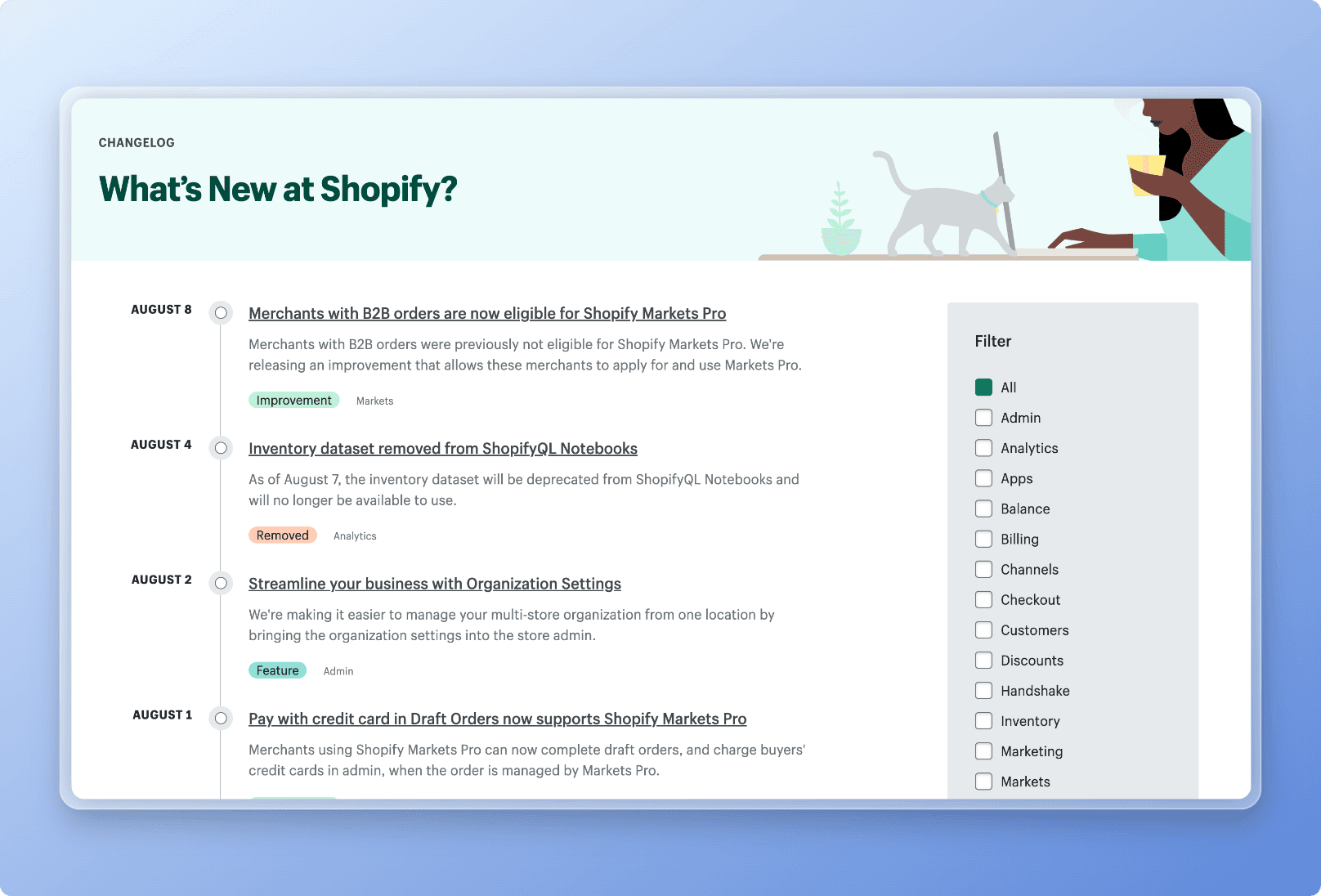
When it comes to organizing release notes, Shopify, a commerce platform that lets you start, grow, and manage a business, sets a great example. They put a great emphasis on categorizing their release notes, grouping changes into categories like "Checkout," "Themes," and "Analytics." This approach allows users to quickly find the information that is most relevant to them, saving time and effort. Whether users are specifically looking for Analytics improvements or want to see what bugs have been squashed in the checkout flow, Shopify's well-structured release notes have them covered.
UiPath's Table of Contents for Seamless Navigation
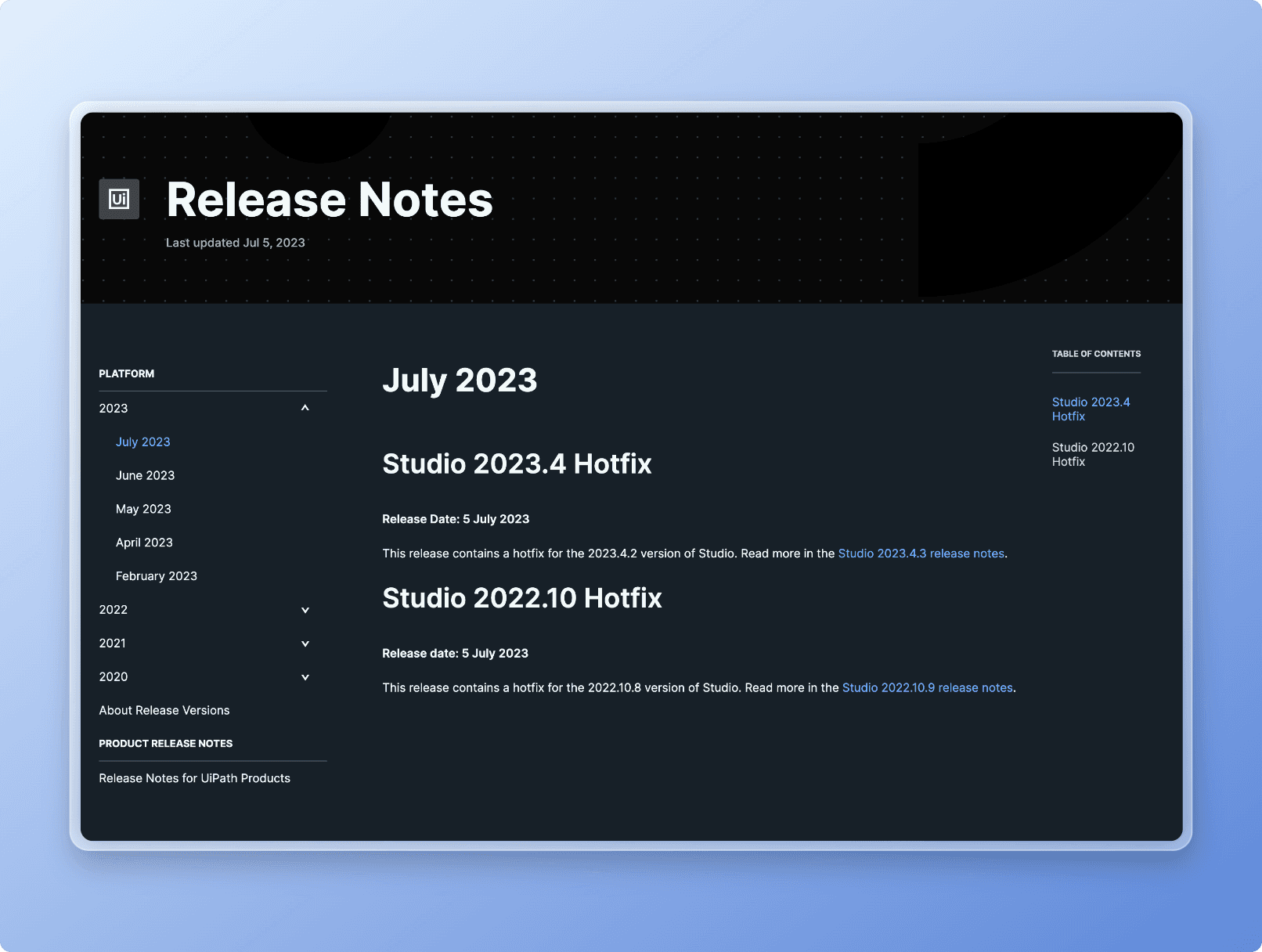
UiPath, a Robotic Process Automation platform, understands the importance of easy navigation in release notes. Their release notes include a table of contents at the beginning, enabling users to jump directly to the sections they are interested in. This thoughtful feature saves users time and effort, as they can quickly find the information they need without having to scroll through the entire document.
Loom's Innovative Use of Video in Release Notes
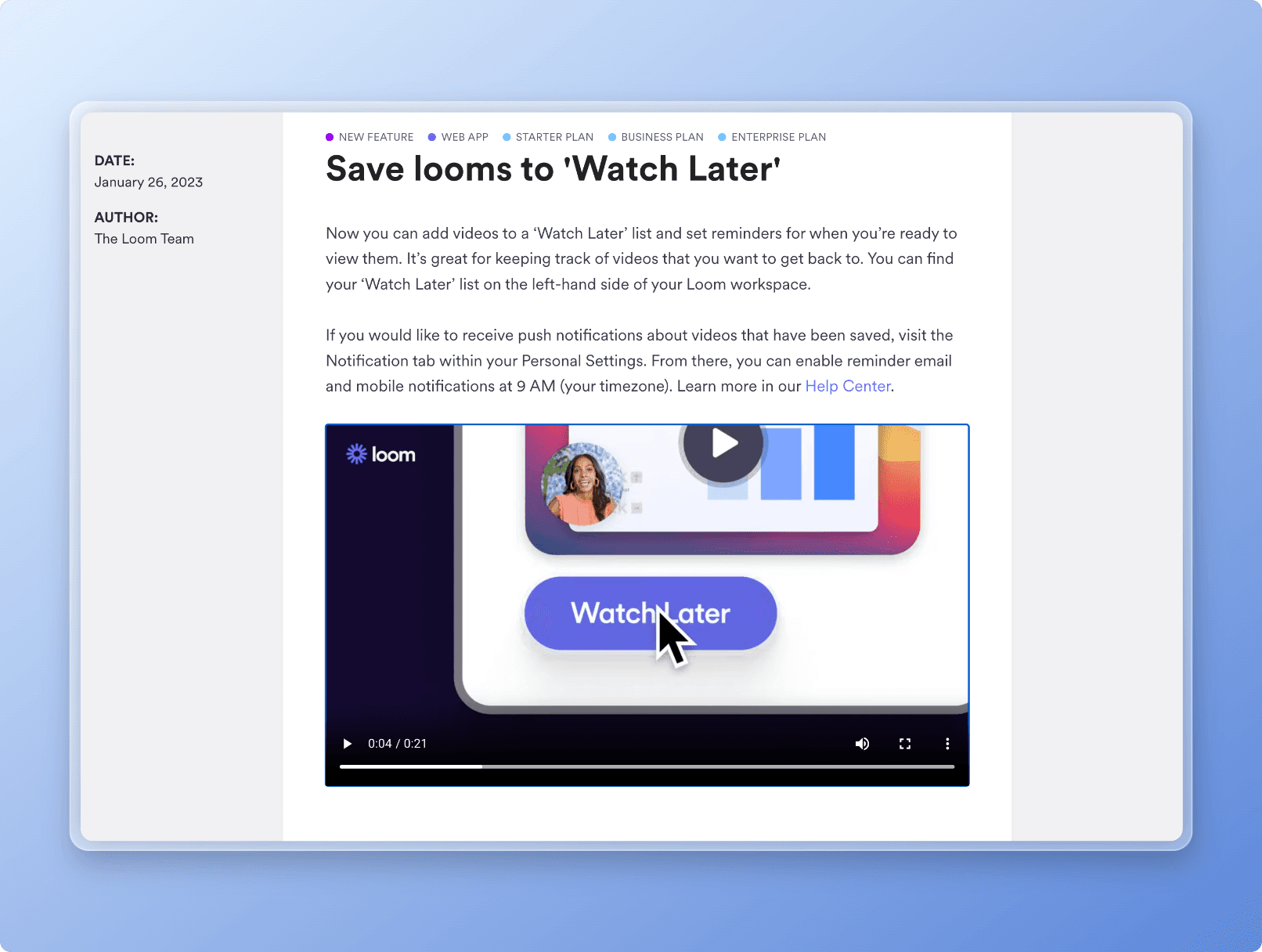
Loom, a video messaging tool that helps you get your message across through instantly shareable videos, embraces the power of video in their release notes. They go beyond traditional text-based updates and provide short videos demonstrating new features or updates. By incorporating videos, Loom makes it easier for users to grasp the changes and visualize how they can benefit from them. This visual approach enhances the user experience, allowing users to understand the updates more intuitively and encouraging them to explore the new features.
Help Scout's Clever Feature Previews in Release Notes
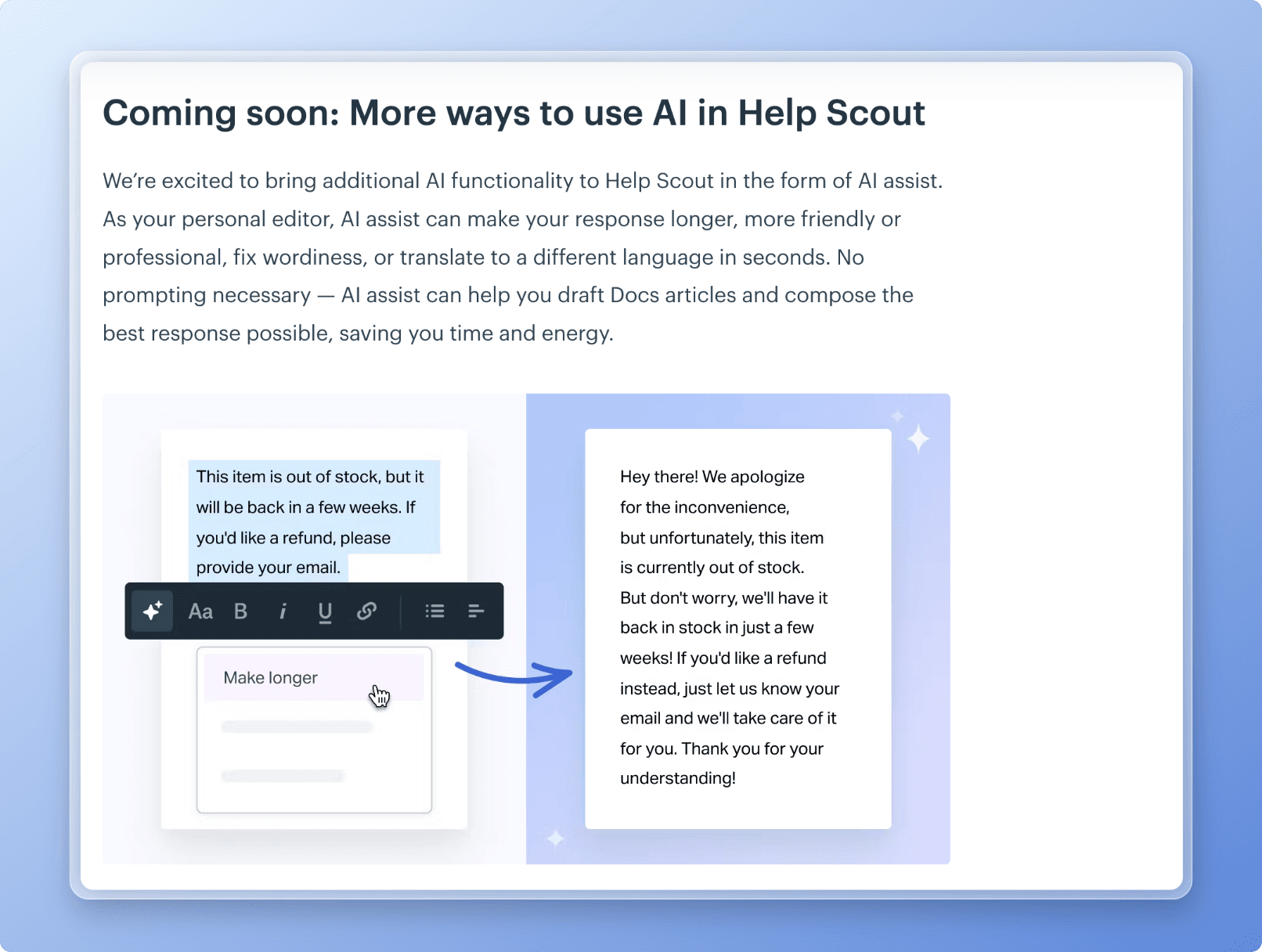
Help Scout, a customer support software, excels at using their quarterly release notes to highlight upcoming features that users to get users excited. By previewing upcoming capabilities, Help Scout help Scout actively prepares users for upcoming changes and offers them to reach out with feedback.
Released's In-App Release Notes
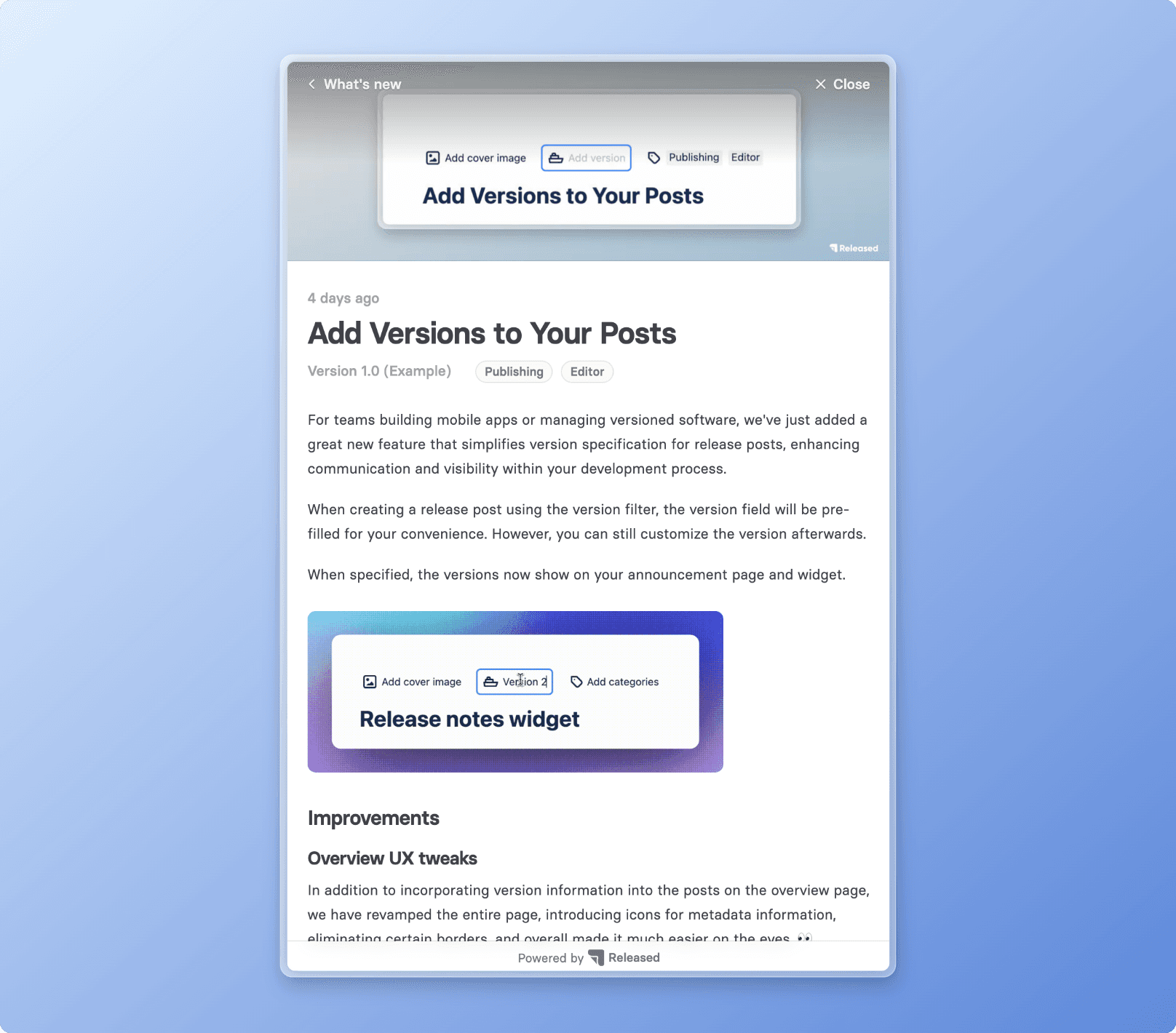
When it comes to keeping users in the loop, we do a pretty good job of it at Released. We use in-app notifications along with release notes on our website to ensure that users are aware of the latest changes as soon as they log in. Whether it's a critical bug fix or an exciting new feature, Released's in-app update announcements keep users informed and engaged, fostering a sense of momentum and trust.
These five examples demonstrate the diverse strategies that companies employ to create exceptional release notes. From clever previews to user-friendly categorization, seamless navigation, innovative use of video, and instant in-app update announcements. These companies have found unique ways to enhance the user experience and make their release notes stand out. By learning from their approaches, businesses can create release notes that not only inform but also engage, educate, and delight their users. For more inspiration, take a look at our compilation of release notes templates and examples.
Maximizing the Impact of Your Product Release Notes
Writing effective release notes is a skill that can greatly improve the overall user experience and foster engagement with your software. By understanding the purpose of release notes, following best practices, and learning from stellar examples, you can create release notes that not only inform users but also strengthen your brand and build a loyal user base. So, whether you're a seasoned writer or just starting your journey, let this ultimate guide be your go-to resource for writing effective release notes that leave a lasting impact.




